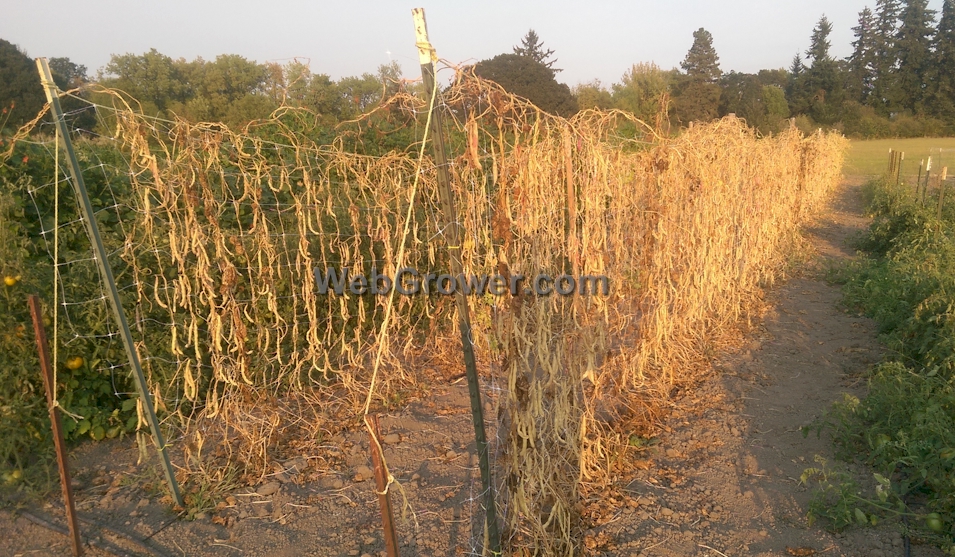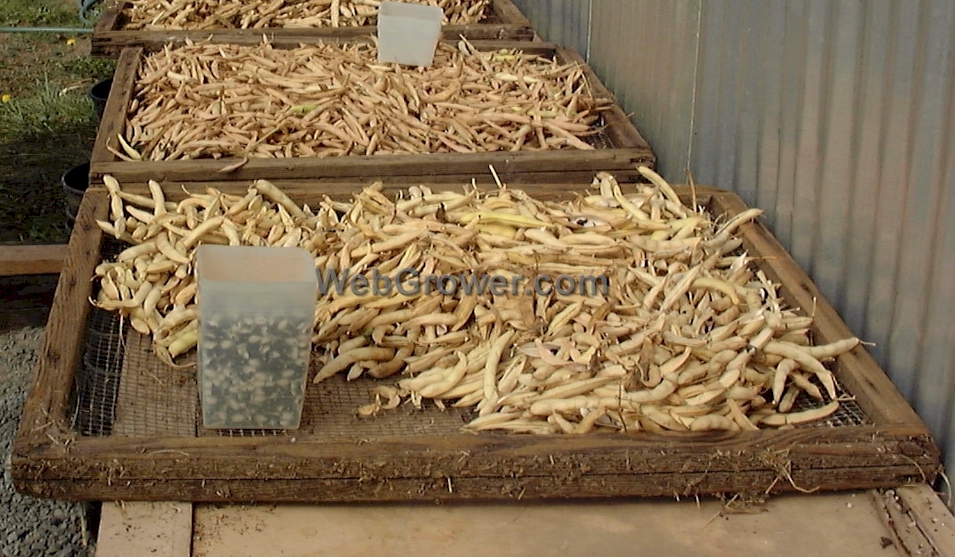Homepage → Seed Saving Information → Saving Bean Seeds
Saving Bean Seeds
Planted October 1, 2024
Last tended to on October 17, 2024
Reading time: 6 minutes

Beans are one of the easiest types of plants to start your seed saving journey with. You simply sow them, keep varieties well isolated from one another, eat and can all that you want, and then allow a portion of them to remain on the vines or plants until they finish their life-cycle, resulting in dried pods, in the fall.
Production:
Removal and proper disposal of plant debris at the end of the gardening season is also beneficial.
Selection:
Referencing the documentation for the varieties that you planted, compare your plants and fruit to the written descriptions and photographs. If you observe any off-type plants, remove them as soon as possible in order to prevent contamination of your crop. This includes diseased or sickly plants, as well as ones that don’t match the variety’s documentation.
Isolation:
The three main types of beans grown in North American gardens are Common or Garden Beans (Phaseolus vulgaris), Lima Beans (Phaseolus lunatus), and Runner Beans (Phaseolus coccineus).
All runner bean varieties will cross with each other, all garden bean varieties with each other, all lima bean varieties with each other, but the different species do not cross. This means that you can safely grow one of each in close proximately to one another without worry of crossing.
Biologically, bean plants produce perfect flowers. That is, they possess both male and female reproductive structures within the same flower. Although this means that they do not require insects to reproduce (pollinate) and form seeds, they are attractive to insects. If you intend to save seed and maintain the purity of the variety, you will need to observe proper isolation.
With a long enough growing season, you can use time to prevent two varieties from crossing. However, this is usually not practical so isolation distances or blossom bagging will need to be maintained.
Keep in mind that this is only an issue if you are raising more than one variety of a bean species (or if you have gardening neighbors raising beans).
| Bean Type | Barriers | No Barriers |
|---|---|---|
| Garden Beans (Phaseolus vulgaris) | 75 feet | 150 feet |
| Lima Beans (Phaseolus lunatus) | 150 feet | 300 feet to 1 mile |
| Runner Beans (Phaseolus coccineus) | 450 feet | 600 feet to 1/2 mile |
The chart above lists recommended distances for maintaining purity. This is of course very dependent on the number of pollinating insects in your area. If you observe few, perhaps you can get away with closer plantings.
Note: If you are experimenting with distances or just want another tool for maintaining plant variety purity in your seed saving toolbox, never sow varieties with similar seed coat characteristics near one another. The color, shape and markings of different varieties are useful in determining crossing but, for example, if two white seeded varieties become crossed up, it will be difficult to discover. Also, keep in mind, the harvested seed will show no indication of crossing. It will only be expressed in the subsequent generation.
You can also reduce the distances between varieties if you can plant them in such a way that they are protected by tall, dense barriers, especially if you also provide plantings of flowering plants more attractive to the pollinators than bean flowers.
If time or distance are not practical for your situation, you will need to bag blossoms to prevent insect pollination. Once self-pollination has occurred and you see small pods developing, remove the bag and mark them so you know not to eat those bean pods. Loosely tying a piece of bright, synthetic fiber, colorfast yarn to the branch is one idea for marking your “seed crop.”
Harvesting:

Ideally, your season is long enough that the bean pods dry down and the plants or vines yellow and loose their leaves prior to fall rains beginning. If this is the case, harvest the dry pods and bring them into an area protected from the elements, with good air circulation, and allow them to finish drying. They need to reach the point where the pods easily split open and the bean seeds pop out. The bean seeds themselves need to be dry enough that they shatter when struck with a hammer. (If the seeds still have too high of a moisture content, they will mash).

If you live in an area with shorter seasons or fall rains are forecasted, wait as long as you can, but pull up the plants and hang upside down in a garage or barn before they get wet and mold or mildew ruins your harvest. Fans are beneficial in circulating air and speeding up the drying process.
Seed Extraction & Processing:
This process is relatively tedious, and I recommend is spreading out your shelling work over several evenings. For home gardening quantities of seed, get a bucket or pail for your waste, a container for your beans, a tray for your lap to work on, a favorite beverage, some good music or a TV show, and sit in a comfy chair getting to work cracking open each pod to separate out the seeds. If you see bad ones, toss them into your waste bucket. Not much more high tech than this.
If you are planning on saving production quantities of seed, it is beyond the scope of this article, but there are mechanical methods for extraction and sorting bean seeds. It requires machinery to thresh, winnow, and screen.
Storage:
As mentioned above, once the beans are thoroughly dry, they shatter when struck with a hammer. At this point, you can put the beans into airtight containers and place them in the freezer for at least 72 hours to kill any insect eggs or larvae that may be hiding inside of them.
If the beans are intended to be used next season or future years for sowing in the garden, you can leave them in the freezer until they are needed. One qualifier there is that they absolutely need to be dried as described, or the process of freezing will damage them at the cellular level. Additionally, the freezer cannot be a “frostless” type commonly found as part of a refrigerator / freezer unit. Dedicated, chest-type freezers are desired for long-term storage.
Otherwise, place your bean seeds in an airtight container with a little desiccant packet and keep in a cool, dark, dry place (like the back of the refrigerator). Refer to our article on seed storage for more information. If the beans are intended to be used for consumption, a cool, dark, dry pantry works great.
Copyright © 1998 - 2024 - All rights reserved
WebGrower.com℠ is a service mark of Victory Horticultural Group, LLC.
• Privacy Statement •
This site participates in the Amazon Services LLC Associates Program, an affiliate advertising program designed to provide a means for sites to earn advertising fees by advertising and linking to amazon.com.